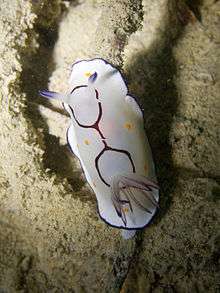Goniobranchus annulatus
| Goniobranchus annulatus | |
|---|---|
 | |
| Goniobranchus annulatus off the coast of Dubai, UAE | |
| Scientific classification | |
| Kingdom: | Animalia |
| Phylum: | Mollusca |
| Class: | Gastropoda |
| (unranked): | clade Heterobranchia clade Euthyneura clade Nudipleura clade Nudibranchia |
| Superfamily: | Doridoidea |
| Family: | Chromodorididae |
| Genus: | Goniobranchus |
| Species: | G. annulatus |
| Binomial name | |
| Goniobranchus annulatus | |
| Synonyms[2] | |
| |
Goniobranchus annulatus is a species of sea slug, a very colourful dorid nudibranch, a shell-less marine gastropod mollusc in the family Chromodorididae.[2]
Description
Goniobranchus annulatus is a large smooth pale-bodied nudibranch with many vivid yellow spots, though these may be absent in some individuals. It has one purple ring around the gills and another ring around the rhinophores. The mantle usually has a purple border. It may grow to 100mm in total length.[3] The gills are triangular in cross-section.[4]
Distribution
This nudibranch was described from Zanzibar. It occurs in the Red Sea, the Indian Ocean, from the East Coast of South Africa to Thailand.[5] It is a Lessepsian migrant and has recently invaded the Mediterranean Sea, presumably through the Suez Canal.[6][7]
Watch
- Goniobranchus annulatus (synonym of Chromodoris annulata) in the Persian Gulf, Abu-Dhabi, 2008.
References
- ↑ Eliot, 1904. On some nudibranchs from east Africa and Zanzibar. Part IV. Proceedings of the Zoological Society of London 1:380-406, pls. 23-24. Plate XXIV
- 1 2 Bouchet, P. (2012). Goniobranchus annulatus. Accessed through: World Register of Marine Species on 2012-04-22
- ↑ King, D. & Fraser, V. 2001. More Reef Fishes and Nudibranchs Struik, Cape Town. ISBN 1-86872-686-X
- ↑ Rudman, W.B., 1999 (April 11) Chromodoris annulata Eliot, 1904. [In] Sea Slug Forum. Australian Museum, Sydney.
- ↑ Gosliner, T. 1998. Goniobranchus annulatus. At: Miller, M. (1998) The Slug Site.
- ↑ Pasternak G., Ziv R., Eyal G., Shefer S., Mienis H.K., Rittner O. & Gali B.S. (2011) On the population of Chromodoris annulata Eliot, 1904 (Mollusca: Opistobranchia: Chromodorididae) off the Mediterranean coast of Israel. Aquatic Invasions 6 (suppl. 1): S91-S93
- ↑ Daskos A. & Zenetos A., 2007. Additions to the knowledge of alien Opisthobranchia of Greece. Aquatic Invasions 2(3): 258-260]
- Rudman W.B. (1987) The Chromodorididae (Opisthobranchia: Mollusca) of the Indo-West Pacific: Chromodoris epicuria, C. aureopurpurea, C. annulata, C. coi and Risbecia tryoni colour groups. Zoological Journal of the Linnean Society 90: 305-407 page(s): 367
- Debelius, H. & Kuiter, R.H. (2007) Nudibranchs of the world. ConchBooks, Frankfurt, 360 pp. ISBN 978-3-939767-06-0 page(s): 145
- Gosliner, T.M., Behrens, D.W. & Valdés, Á. (2008) Indo-Pacific Nudibranchs and seaslugs. A field guide to the world's most diverse fauna. Sea Challengers Natural History Books, Washington, 426 pp. page(s): 218
- Johnson R.F. & Gosliner T.M. (2012) Traditional taxonomic groupings mask evolutionary history: A molecular phylogeny and new classification of the chromodorid nudibranchs. PLoS ONE 7(4): e33479
| Wikimedia Commons has media related to Goniobranchus annulatus. |